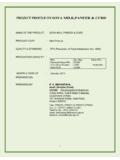Transcription of 2010 JMPR Monograph Feb 24 2011 - fao.org
1 dicamba 939 dicamba (240) First draft prepared by Dr. Yukiko Yamada, Ministry of Agriculture, Forestry and Fisheries, Tokyo, Japan EXPLANATION dicamba , a systemic broad-spectrum herbicide, is used in a variety of crops. Its mode of action is similar to that of endogenous auxin (IAA) and other auxin-type herbicides and appears to involve cell wall plasticity and nucleic acid metabolism. In sensitive broad-leaved weeds, the induction of 1-aminocyclopropane-1-carboxylic acid (ACC) synthase in the biosynthesis of ethylene is a primary and rapid response to auxin herbicides. Within a few hours after treatment, increases are induced in ACC synthase activity, followed by increased ACC concentration and ethylene formation in the shoot tissue.
2 Ethylene causes epinastic growth and tissue swelling. It also stimulates the biosynthesis of abscisic acid (ABA), which mediates stomatal closure. Within 24 hours, these effects limit photosynthetic activity and biomass production, and are accompanied by the over-production of reactive oxygen species, particularly hydrogen peroxide, in the tissue. Growth inhibition, senescence and tissue decay are the consequence of this cascading process. Since the first approvals of dicamba in 1962, it has been registered in about 100 countries worldwide. It was identified as a priority new compound at the Forty-second Session of the CCPR in 2009 (ALINORM 09/30/24, para. 193) for evaluation for the first time by the 2010 JMPR. The Meeting received information on physical and chemical properties, animal and plant metabolism, environmental fate, analytical methods, storage stability, use patterns, processing and farm animal feeding.
3 The specification of dicamba was developed by the Joint FAO/WHO Meeting on Pesticide Specification and published in 2001. IDENTITY ISO common name: dicamba Chemical name IUPAC: 3,6-dichloro-2-methoxy-benzoic acid CAS: 3,6-dichloro-2-methoxy-benzoic acid CAS Registry No.: 1918-00-9 CIPAC No.: 85 Synonyms for active substance: BAS 183 H Reg. No. 196 095 SAN 837 R084451 940 dicamba Structural formula: Molecular formula: C8H6Cl2O3 Molecular weight: PHYSICAL AND CHEMICAL PROPERTIES Pure active ingredient Property Results Reference Appearance: White granular solid Widlak, 1993b, 1993/5271 Odour: Weak neutral, slightly aromatic and pungent Buck, 1993a, 1993/5269 Melting point: 114 116 C (metal block) Widlak, 1993a, SAN837/5293 Temperature of decomposition: Thermal decomposition starts at about 230 C before boiling.
4 Das, 1999, 1999/5000168 Relative density: at 25 C Pal, 1993, 1993/5254 Vapour pressure: 10-3 Pa at 25 C Chen, 1994, 1994/5202 Henry s Law Constant at 25 C (calculation): 10-4 Pa m3/mol Burkhard, 1995a, 1999/5000170 Solubility in water at 25 C: Unbuffered: In buffer soln pH : pH : pH : g/L (pH ) > 250 g/L > 250 g/L > 250 g/L Kettner, 1999a, 1999/5000169 Solubility in organic solvents at 25 C: Hexane: Acetone: Methanol: Ethyl acetate: Octanol: Toluene: Dichloromethane g/L > 500 g/L > 500 g/L > 500 g/L 490 g/L 180 g/L 340 g/L Das, 2001b, 2001/5003583 Octanol-water partition coefficient at 25 C (logPow):pH : pH : pH : Kettner, 1999b, 1999/5000167 dicamba 941 Property Results Reference Hydrolysis: 25 C 50 C pH 4: pH 5 pH 7: pH 9: - Stable for 1 month Stable for 1 month Stable for 1 month Stable for 2 weeks Stable for 2 weeks Stable for 2 weeks Stable for 2 weeks Morgenroth, 2000, 2000/5000164 Direct photo-transformation of purified active substance in water (pH 7, 25 C) Pseudo first-order photolysis DT50: days Rate constant: day-1 Corresponding to : DT50: days Rate constant: day-1 Based on noon spring sunlight data for 40 N latitude No degradation products > 10% Sen et al, 1993, 1993/5237 Quantum yield of direct photo-transformation.
5 For geographical latitudes 30 N, 40 N and 50 N in spring and summer, near surface, with =1 included: DT50: 13 21 days Rate constant: day-1 Schmidt, 2002, 2002/5004807 Dissociation in water at 25 C: pKa= Bebel, 1993, 1993/5249 Burkhard, 1999b, 1999/5000159 Estimated photochemical oxidative degradation: DT50= days for OH attack ( 106 OH-radicals/cm3 and a 12 hour day) Stamm, 1998, 1998/5000050 UV absorption in methanol: Neutral: Acidic: Basic: 228 nm (10130 L/mol cm), 737 nm 228 nm (10119 L/mol cm), 1028 nm 228 nm (10522 L/mol cm), 343 nm Technical material Property Results Reference Appearance: Light cream/tan solid composed of granules, lumps and flakes Widlak, 1993c, 1993/5252 Odour: Moderate, neutral, pungent or medicinal Buck, 1993b, 1993/5270 Flammability: Not flammable Angly, 1999b, 1999/5000162 Explosive properties: Not explosive under effect of thermal, shock or friction.
6 Angly, 1999b, 1999/5000157 Surface tension: nM/m at g/L aqueous solution and 20 C Martin, 1999, 1999/5000158 Oxidizing properties: Not considered as oxidizing substance. Angly, 1999c, 1999/5000166 Formulations: Emulsifiable concentrate (EC) formulation containing 50 or 87 g ai/L in combination with other 942 dicamba ClClOCOOHClClOCOOHOHP roperty Results Reference active ingredients Soluble concentrate (SL) formulation containing 30, , 70, 84, 90, 100, 110, 120, 160, 213, 240 or 480 g ai/L alone or in combination with other active ingredients Suspension concentrate (SC) formulation containing 132 g ai/L in combination with other active ingredients Water dispersible granule (WG) formulation containing 40, , 50, 60, 61, 63, 66, 70 or 80 g ai/L alone or in combination with other active ingredients METABOLISM AND ENVIRONMENTAL FATE The following links manufacturer code name and structure or description of the compounds appearing in the various metabolism and environmental fate studies.
7 Structure of compounds appearing in metabolism and environmental fate studies Code name Chemical names Found in Other names Structure dicamba (Parent compound) 3,6-dichloro-2-methoxy-benzoic acid (CAS, IUPAC) Cow Goat Hen Sugar cane Soya beans Cotton Wheat Soil SAN 837H I8 U1 F1 K1 L1 Ft1 R084451 5-OH dicamba 2,5-dichloro-3-hydroxy-6-methoxy-benzoic acid (CAS, IUPAC) Goat Hen Sugar cane Soya beans Cotton Wheat NOA 405873 U2-3 Glucoside of 5-OH dicamba Glucoside of 2,5-dichloro-3-hydroxy-6-methoxy-benzoic acid (IUPAC) Sugar cane Wheat I7-conjugate (I7-glucoside) O-Glc 5-OH dicamba dicamba 943 ClClOHCOOHClOHClNH2 ClOHClClClOHCOOHOHCode name Chemical names Found in Other names Structure DCSA 3,6-dichloro-2-hydroxy-benzoic acid (CAS, IUPAC) Cow Goat Hen Sugar cane Soya beans Cotton Wheat Soil Dichlorosalicylic acid, 2-OH dicamba NOA414746 I6, DCHBA U2-1 F2 K2 L2 Ft2 DCHB R733985 DCSA Glucuronide Glucuronide of 3,6-dichloro-2-hydroxy-benzoic acid (IUPAC) Cow Sugar cane Wheat Glucuronide of DCHBA Glucoside of 2-OH dicamba I6-conjugate (I6-glucoside) O-Gluc-DCSA 2A36 DCP 2-amino-3,6-dichloro-phenol (CAS, IUPAC) Hen (liver) DCP 2,5-dichlorophenol (CAS, IUPAC) Cow (urine)
8 Dichlorophenol DCGA 2,5-dichloro-3,6-dihydroxy-benzoic acid (CAS, IUPAC) Soya beans Sugar cane Cotton Wheat Soil 3,6-Dichloro-gentisic acid, 2,5-DiOH dicamba I5 R740230 Glucoside of DCGA Glucoside of 2,5-dichloro-3,6-dihydroxy-benzoic acid (IUPAC) Wheat I5-conjugate (I5-glucoside) O-Glc-DCGA Radiolabelled dicamba Used in Metabolism Studies In plant and animal metabolism studies, dicamba which was uniformly labelled with 14C in the phenyl ring was used. No radioactive carbon was incorporated into other carbon atoms. (see Table 1) 944 dicamba ClClOCOOH* Table 1 Specific activity and purity of radio-labelled compound used in the metabolism studies Study on Specific activity MBq/mg Purity* % Lactating goat ( mCi/mmol or 191 Ci/mg) Lactating cow ( mCi/mmol or Ci/mg) > 99 Laying hen (1st study) ( mCi/mmol or 191 Ci/mg) Laying hen (2nd study) ( mCi/mmol or Ci/mg) > 99 Wheat ( mCi/mmol or Ci/mg) Soya beans ( mCi/mmol or Ci/mg) > 98 Cotton ( mCi/mmol or Ci/mg)
9 > 98 Cotton ( mCu/mmol or Ci/mg) 98 Sugar cane ( mCi/mmol or Ci/mg) > 98 * Checked using TLC. dicamba readily forms organic or inorganic salts in formulated products. However, concentrations are given for the pure acid rather than the salts throughout the current metabolism evaluation. Animal metabolism The Meeting received information on the results of studies on lactating goats and cows, and laying hens. Metabolism studies on laboratory animals including rats were reviewed in the framework of toxicological evaluation by the current JMPR. Generally, there were no differences in the disposition of dicamba between species and sexes. It was also shown that the anionic counter-ion of dicamba salts did not influence the absorption, metabolism or elimination of dicamba .
10 In rat study, more than 95% of the administered dose is excreted in the urine with less than 5% via faeces. dicamba was rapidly absorbed with peak levels within the first hour after administration and the peak levels were proportional to the dose. Only very minor portion of the administered dose was found in the organs. In urine, kidney and liver samples, more or less 90% of the recovered radioactivity was accounted for by the parent compound. Very low amounts of glucuronated dicamba , demethylated dicamba , 5-OH dicamba and glucuronated DCSA were found in pooled urine samples. dicamba is poorly metabolized in laboratory animals and the metabolic pathway includes demethylation, hydroxylation and glucuronic acid conjugation. Rat metabolism is reviewed by JMPR at its present meeting. dicamba 945 Lactating goats Three lactating goats were orally given gelatine capsules once a day (Guirguis , Yu 1994).

















